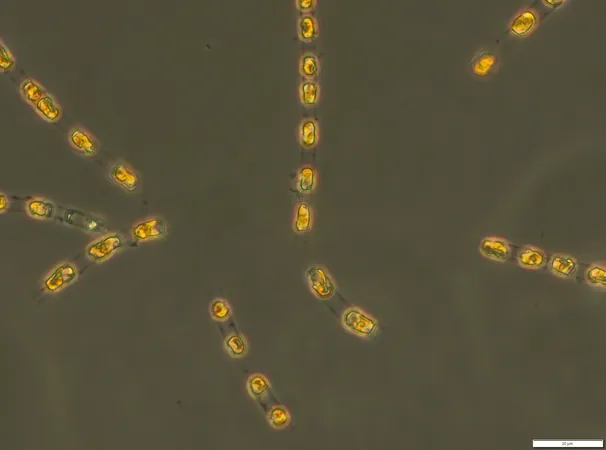
Scientists Bring 7,000-Year-Old Algae Back to Life: A Breakthrough that Could Change Everything!
2025-03-28
Author: Wei Ling
Ancient Algae Revived
In an extraordinary scientific achievement, researchers from the Leibniz Institute for Baltic Sea Research Warnemünde (IOW) successfully revived ancient algae that had lain dormant in the depths of the Baltic Sea for nearly 7,000 years. Despite millennia of inactivity, shrouded in darkness and deprived of oxygen, these prehistoric algae have emerged from the abyss, illustrating the remarkable resilience of life.
Groundbreaking Research
This groundbreaking research was published in *The ISME Journal* and is part of the PHYTOARK project, which seeks to unravel the mysteries of the Baltic Sea’s past and predict its ecological future. By analyzing sediment that had built up over thousands of years, scientists were able to unlock valuable secrets about historical ecosystems.
The Concept of Dormancy
Dormancy is commonly observed across various life forms, from microorganisms to larger animals, allowing them to endure harsh conditions. In this case, phytoplankton—tiny plants that play an essential role in aquatic ecosystems—had entered a state of dormancy, sinking to the seabed, where they were preserved under layers of sediment.
Resurrection Ecology
Sarah Bolius, a phytoplankton expert at IOW and lead author of the study, explains, “These sediment deposits act as time capsules, preserving crucial information about ancient biological communities and their evolutionary changes.”
The research team leveraged a method referred to as "resurrection ecology," where dormant cell stages—each linked to specific periods in the Baltic Sea’s history—were converted back to live specimens. This innovative approach allows scientists to thoroughly investigate genetic shifts and adaptations in relation to past environmental changes.
The Revived Samples
Utilizing sediment cores taken from depths of 240 meters in the Eastern Gotland Deep, the team awakened viable algae from nine samples, with the diatom species Skeletonema marinoi being the sole phytoplankton revived from all tested sediments. Remarkably, the oldest samples, dating back approximately 6,871 ± 140 years, showcased vitality and resilience comparable to modern strains.
Not only did these ancient algae retain their ability to grow and reproduce, but they also demonstrated effective photosynthetic performance, producing oxygen at rates akin to current algae populations. This breakthrough could have profound implications, allowing researchers to understand how climate events from millennia ago shaped genetic adaptations still detectable in present-day ecosystems.
Genetic Analysis and Evolution
In a fascinating twist, the genetic analysis revealed that these algae formed distinct genetic groups over the millennia, ruling out contamination and highlighting the evolutionary shifts of S. marinoi populations in the Baltic Sea.
Significance of Dormancy
The ability of organisms to survive in a dormant state for extensive periods is documented across various species, from plant seeds to tiny crustaceans, with some surviving for centuries. However, successfully reviving such ancient algae is a rare feat; these tiny diatoms rank among the oldest organisms ever brought back to life from an intact dormant state.
Future Research and Implications
"Successfully reactivating such ancient algae marks a pivotal advance in 'Resurrection Ecology,' paving the way for laboratory experiments that replicate various stages of Baltic Sea evolution," says Bolius. Future explorations will subject these revived algae to different environmental conditions to gather further insights.
As the field of resurrection ecology expands, these findings could illuminate the paths of genetic change over millennia, marking a significant leap forward in our understanding of how organisms adapt over time. With every revival, we inch closer to carving out the expansive narrative of life’s resilience throughout Earth’s dynamic history.


 Brasil (PT)
Brasil (PT)
 Canada (EN)
Canada (EN)
 Chile (ES)
Chile (ES)
 Česko (CS)
Česko (CS)
 대한민국 (KO)
대한민국 (KO)
 España (ES)
España (ES)
 France (FR)
France (FR)
 Hong Kong (EN)
Hong Kong (EN)
 Italia (IT)
Italia (IT)
 日本 (JA)
日本 (JA)
 Magyarország (HU)
Magyarország (HU)
 Norge (NO)
Norge (NO)
 Polska (PL)
Polska (PL)
 Schweiz (DE)
Schweiz (DE)
 Singapore (EN)
Singapore (EN)
 Sverige (SV)
Sverige (SV)
 Suomi (FI)
Suomi (FI)
 Türkiye (TR)
Türkiye (TR)
 الإمارات العربية المتحدة (AR)
الإمارات العربية المتحدة (AR)